Do you love leeks? I sure do. Subtle in flavor, melty in texture when cooked, a bit crunchy as a raw garnish, they’re one of my favorite vegetables. When a recipe calls for leeks, it usually indicates to use the white and light green parts only and to either discard the “tough dark green tops” or save them for another use. Grocery stores sometimes even sell leeks with those dark green tops already sliced off for you, as they seem to have been deemed quite inconvenient to have in your kitchen.
And what of those “other uses”? Usually it refers to using the green tops as an add-in for soup or stock, only to be removed once they’ve imparted their luscious layer of flavor – and then yes, discarded. Or you can even store them in the freezer for when you’re ready to make soup or stock. Well, my apartment-sized freezer space is limited, so freezing them (and other vegetable scraps) for when I make soup or stock is not very practical.
One day, I just got tired of discarding those tops! After all, we cook up all kinds of vegetables that are tough to start out with, don’t we? Think about so many of those greens we love in one form or another: escarole, chard, kale, collard greens, mustard greens, beet tops. They all start out pretty tough and yet end up nice and tender when cooked in a nice blend of fat, liquid and seasonings. In other words, they are braised. So that’s what I did. And let me tell you, these turned out so tender and creamy that I will never throw away those dark green tops again!
The whole process will take about 45 minutes, but very little of that is “active” time on your part. What follows is more of a guideline than an actual recipe. Feel free to create your own variations, and add your own seasonings.
All you’ll need are some basic ingredients:
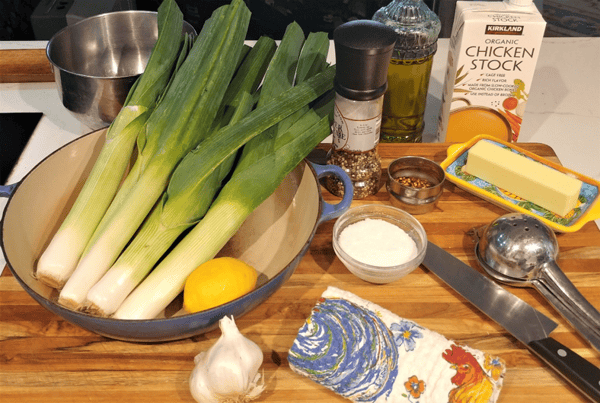
In addition to the leeks, I use olive oil, butter, garlic, chicken stock (preferably unsalted or low-salt), kosher salt, dried chili flakes, ground black pepper, and lemon juice. If you want to make a vegan-friendly version, go ahead and replace the butter with more olive oil, and substitute the chicken stock with vegetable stock.
While you slice the leek tops, start heating your pan over medium heat. Use a pan that has a lid, since you’ll be covering these for part of the time. Slice the dark green part of the leek, making about 1/4” – 1/2” slices.
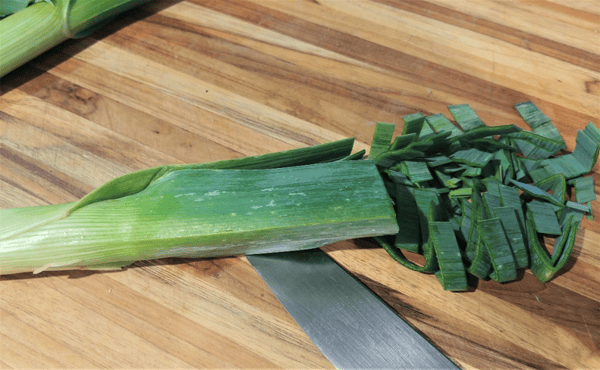
I like to leave the leek whole and just start slicing from the dark green end. This keeps me from having to hold the leek together as I’m slicing, since it’s already all attached at the root (white) end.
Stop slicing once you get to the light green part of the leek.
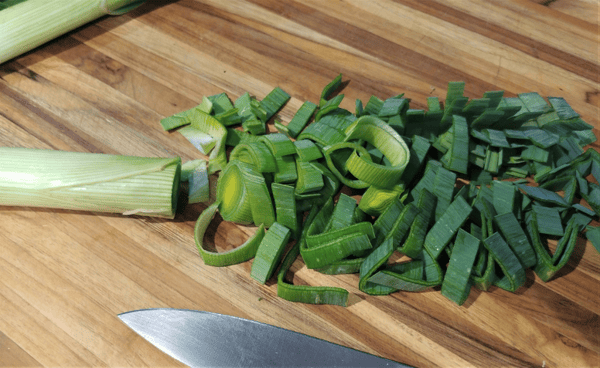
Put all your dark green slices into a colander and give them a good rinse (leeks can get rather sandy).
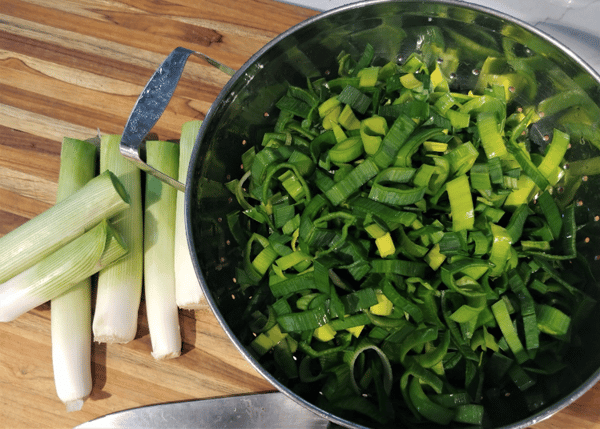
Now it will be the white and light green parts of your leeks that “get reserved for another use” – how’s that for karma?
Melt equal parts butter and olive oil together in your warm pan. With six medium-sized leeks, I ended up with just under 1.5 pounds of sliced tops. I used about 3 Tablespoons of butter and about 3 Tablespoons of olive oil. Depending on how many leeks you use, you may vary these quantities a bit. What you’re looking for is a nice, generous coating on the leeks.
Once the butter is melted, add the leeks along with 2 lightly crushed garlic cloves.
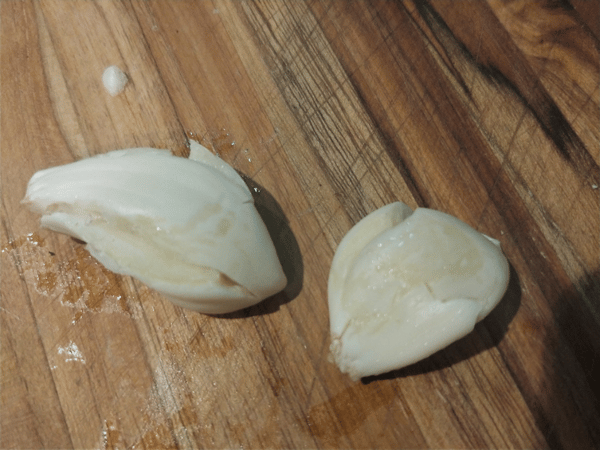
I like just a hint of garlic flavor, so crushing them ever-so-slightly works for me. If you prefer more garlic flavor, then slice or mince them. You can also use more garlic, if you wish.
Sprinkle some salt (about a teaspoon) and dried chili flakes (about 1/4 teaspoon) and give everything a nice toss to coat the leek tops evenly. While you want to add some salt at this point to draw out some water from the leek tops and to prevent browning, you are better off under-salting. This is because your braising liquid will reduce, so any seasoning you add now will become more concentrated. You can always add more salt, to taste, later. (Note that if you’re using a salted chicken or vegetable stock, you should go a little lighter on the salt at this point.) The same goes for the chili flakes: add a little now so they soften up during the braising process and release their flavor. If you decide you want more heat at the end, you can always add a few grindings of black pepper. I find that I rather like the flavor of the leeks and don’t want to overpower them with seasoning, so I try to use just enough to round out their natural flavor.
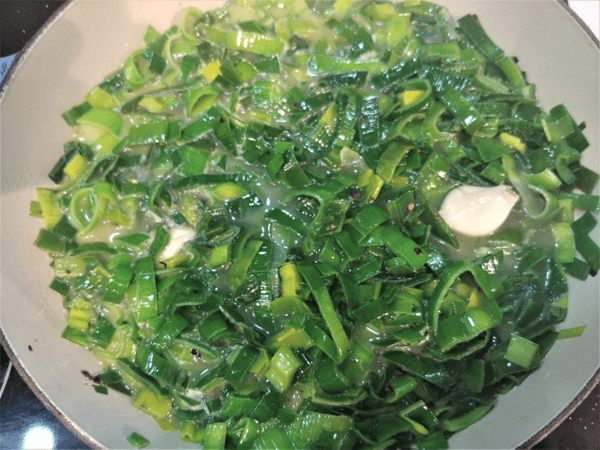
Let everything cook together for about 5 minutes, giving the leeks a chance to soften up a bit. Then add about a cup of chicken stock. Keeping the heat on medium, bring the mixture to a simmer, then lower the heat to medium-low. Cover your pan and cook for 30 minutes. Literally walk away from your stove (or move on to preparing the rest of your meal).
Once you remove the cover, you’ll immediately see a change in the texture of the leek tops (silky soft and creamier).
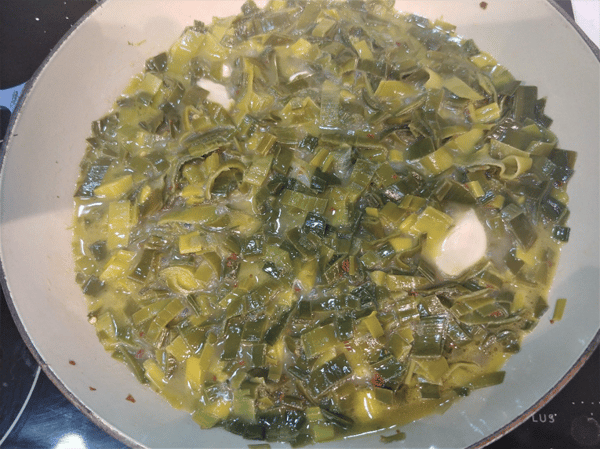
Now turn the heat back up to medium and let the stock reduce to a point where there is just a small amount of liquid remaining in the pan.
You can see that when I drag my wooden spoon through the leek mixture, there is a clean trail left behind. Now it’s time to take it off the heat. Remove the garlic cloves. Don’t worry if some of the garlic broke off into pieces; you don’t need to pull every remnant. Taste the liquid and correct the seasoning, if necessary, by adding more salt or freshly ground black pepper. Adding dried chili flakes at this point would not give them enough time to soften, so adding freshly ground black pepper is a better option. I also like to add a squeeze of fresh lemon juice to liven things up a bit (I used half a lemon).
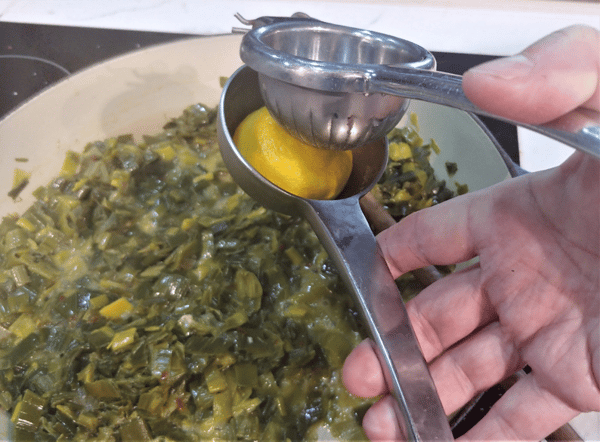
Stir the lemon juice through. Transfer to a serving dish (or a storage container if you’re not using it right away). While the mixture is still hot, I like to add a drizzle of olive oil for one more little layer of flavor.
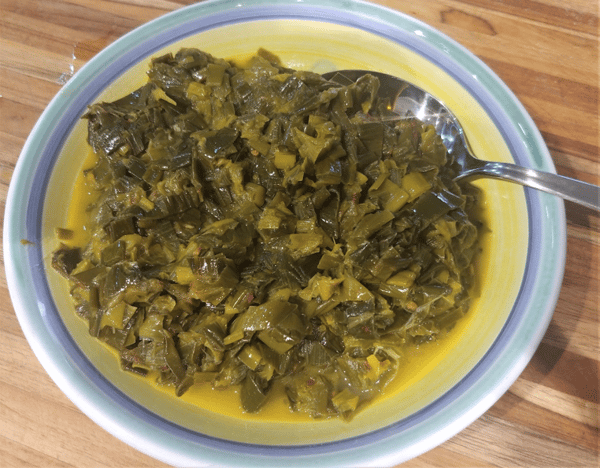
You can enjoy these all on their own as a side dish (you can even add a splash of cream), but they are also perfect for spooning over fish, mixing with rice or beans, and tossing with pasta, to name just a few ideas. You can vary your seasonings, depending on your own taste or what you will used these for. Maybe some thyme or tarragon will work well, especially if you’re going to use this with fish. You may decide not to use dried herbs or spices, but to use fresh herbs instead – in which case, you would want to add them at the end for optimal flavor. And the next time you see a bunch of leeks at the grocery store with the dark green tops already cut off, try to suppress your urge to ask the produce person to take you to the back so you can round them up and take them home!
At The Chopping Block, we feature braising in many of our classes. While this post focused on braising vegetables, the process is pretty much the same for meats, where especially tougher cuts benefit from the braising process. Check out the following classes to boost your braising skills:
- Cast Iron and Crock Pot Cookery (braising beef, poultry and pork) Saturday, February 1 12pm Lincoln Square
- Winter Soups and Stews (braising beef and chicken) Tuesday, February 11 6:30pm Lincoln Square
- Parisian Pleasures (braising poultry) Wednesday, February 19 7pm Lincoln Square
- Culinary Adventure: A Trip to the Middle East (braising lamb) Thursday, February 27 7pm Lincoln Square
- Tuscan Winter Feast (braising pork) Saturday, February 29 7pm Lincoln Square
- Hop to It: Celebrating the Leap Year (braising rabbit) Saturday, February 29 6pm Merchandise Mart












